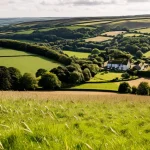Overview of UK Wildlife You May Encounter While Camping
Camping wildlife in the UK offers a rich tapestry of creatures across several groups: mammals, birds, insects, and reptiles. Mammals such as foxes, badgers, and deer are commonly found near woodland edges and open fields, where they forage and rest. Birdlife is abundant, with species like robins, woodpeckers, and owls frequently spotted around campsites nestled in forests or near lakes. Insects play a vital role in the ecosystem; expect to see butterflies, beetles, and various pollinators thriving in wildflower meadows. Reptiles like slow worms and common lizards appear in heathlands or sunny, open areas.
Wildlife encounters UK camping enthusiasts experience often depend on the habitat type. Woodlands, heathlands, riversides, and coastal areas all support distinct animal communities, creating varied opportunities for observation. Seasonal changes drastically affect wildlife visibility; spring and summer bring out active mammals and insects, while autumn encourages bird migrations and feeding behavior. Winter sights become scarcer but may include tracks or signs of animals sheltering nearby.
In the same genre : What are the top scenic camping spots in the UK?
Understanding these patterns enriches camping wildlife experiences and helps campers appreciate UK wildlife within their natural settings.
Common Mammals Seen While Camping in the UK
Discovering UK wild mammals while camping adds a special thrill to your outdoor experience. Many campers spot mammals in UK campsites, especially in wooded or rural areas. Among the most common mammals in UK campsites are deer, foxes, hedgehogs, and badgers.
Also read : What Are the Benefits of Exploring the UK’s Natural Landscapes Through Camping?
Deer, often seen at dawn or dusk, graze near woodland edges. Foxes, with their adaptable nature, may approach campgrounds quietly during twilight. Hedgehogs and badgers are predominantly nocturnal, making evening or nighttime the best time for a quiet wildlife encounter. These mammals in UK campsites usually avoid disturbance, so patience and low noise levels increase your chances of sightings.
Habitats near popular camping regions, such as the Lake District, New Forest, and Peak District, provide rich environments for these species. The hedgerows, dense forests, and open glades around campsites create ideal shelter and feeding grounds for local mammals. Understanding these habits ensures campers enjoy safe, respectful wildlife observation while appreciating the natural diversity of UK wild mammals.
Birds to Watch for Around UK Campsites
Discover the feathered locals that enliven your camping experience.
When camping in the UK, bird spotting UK offers rewarding opportunities to observe woodland birds and more. Among the most notable species to watch are the familiar robin, whose bright red breast is a welcome sight. Owls often announce their presence with distinctive calls after dusk, perfect for campers seeking a touch of nocturnal nature. Woodpeckers, with their rhythmic drumming on tree trunks, provide both sight and sound cues for identification. Raptors, like kestrels and buzzards, soar above woodlands, adding dynamic movement to your birdwatching.
To identify these camping birds effectively, focus on both appearance and sound. Listen for the robin’s melodious song or the owl’s haunting hoot. Observe woodpeckers’ unique flight patterns and raptors’ soaring glides. Using binoculars and a local bird guide can enhance your experience significantly.
Respectful birdwatching etiquette, such as maintaining a quiet distance and avoiding direct interaction, ensures the birds remain undisturbed. Bringing a notebook to jot down sightings helps solidify your newfound knowledge of UK woodland birds around campsites.
Insect and Invertebrate Life Near Campsites
Camping in the UK means sharing your outdoor space with a variety of invertebrates UK enthusiasts love to spot. Among the common insects you’ll encounter are midges, bees, butterflies, and beetles. Midges, notorious for their bites, tend to be more active damp or cool evenings, which can be a nuisance if you’re not prepared. Bees and butterflies, however, add vibrant life to your surroundings, often hovering near flowers or lush foliage.
Understanding these UK camping insects helps balance their benefits and drawbacks. Bees play a crucial role in pollination, supporting local flora and indirectly enhancing the campsite’s natural beauty. Butterflies also indicate a healthy ecosystem. Meanwhile, beetles contribute by breaking down organic matter, enriching the soil you walk on.
When it comes to insect encounters camping, some simple precautions can ease worries about bites and stings. Wearing long sleeves and using insect repellent around exposed skin reduces the risk. Also, keeping food sealed and avoiding strong scents minimizes attraction of unwanted insects. Awareness and respect for these small creatures ensure a safer, more pleasant camping experience amidst nature’s fascinating invertebrate world.
Reptiles and Amphibians in the UK Wilderness
When camping in the UK, you might wonder about the chances of encountering reptiles UK camping. The most common reptiles include slow worms, common lizards, and adder snakes. Among amphibians UK wildlife, frogs, toads, and newts are frequent visitors to damp areas near ponds and streams. These species thrive in specific habitats. Reptiles prefer sunny, dry environments like heathlands, grasslands, and woodland edges, while amphibians UK depend on moist, shaded spots that support their skin’s need for hydration.
Spotting reptiles camping is best done during warm daylight hours when lizards and snakes bask. Look under logs or stones carefully without disturbing them. Amphibians UK observation is often more successful at dusk or dawn near water bodies where frogs and newts breed. Always observe from a distance to avoid stressing these delicate creatures.
Respecting their habitat is vital. Do not touch or move reptiles or amphibians UK species, as handling can distress them or damage protective skin coatings. Using a pair of binoculars or a camera with zoom allows safe, rewarding encounters. Following these steps ensures you enjoy wildlife spotting responsibly and increase your chances of seeing these fascinating reptiles UK camping and amphibians.
Wildlife Spotting Tips for UK Campers
Quiet observation is key.
When camping in the UK, mastering wildlife spotting tips starts with minimizing noise. Animals in woodlands or near water quickly detect human presence. Move slowly, speak softly, and avoid sudden movements to increase your chances of seeing natural behaviours.
Early morning and late evening are the best times for camping wildlife observation. Many animals are crepuscular, meaning they are most active during dawn and dusk. Planning your outings around these periods enhances encounters with deer, foxes, or owls.
For effective wildlife observation, pack binoculars and a camera with a zoom lens. This gear lets you keep a respectful distance, protecting both you and the wildlife. When photographing, avoid flash, as it can disturb animals and alter their natural behaviour.
Documenting sightings in a notebook or app supports your experience and contributes to nature records. Always respect animal habitats; do not chase or feed wildlife, as this disrupts ecosystems. Following these wildlife spotting tips helps you enjoy UK camping responsibly while fostering appreciation for its rich biodiversity.
Safety and Respect: Guidelines for Camping Near Wildlife
When camping near wildlife, prioritising wildlife safety camping practices is essential. Larger mammals, such as deer or wild boar found in the UK, can pose risks if approached too closely or startled. Maintaining a safe distance reduces the chance of aggressive encounters. Equally important is awareness of stinging insects like wasps and bees, which can be provoked if food is left uncovered or sugary drinks spilled.
The UK has strict wildlife camping rules designed to protect both campers and animals. These laws prohibit feeding or attempting to touch wild animals, as well as camping too close to sensitive habitats. National parks and nature reserves often enforce specific regulations to minimise human impact.
To respect wildlife habitats and prevent disturbance, campers should follow simple yet effective guidelines: set up tents in designated areas, avoid loud noises, and store food securely. Leaving no trace also means disposing of waste thoughtfully and refraining from altering natural features. By adhering to these principles, you help preserve biodiversity while ensuring your safety in the outdoors.


